History of bioelectricity
The history of bioelectricity dates back to ancient Egypt, where the shocks delivered by the electric catfish were used medicinally.
In the 18th century, the abilities of the
Fish that give shocks
Ancient Egypt
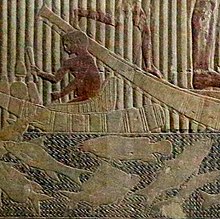
The
Ancient Greece and Rome
Electric fishes were known to Aristotle, Theophrastus, and Pliny the Elder among other classical authors. They did not always distinguish between the marine torpedo ray and the freshwater electric catfish.[1]
Eighteenth century
The naturalists Bertrand Bajon, a French military surgeon in
-
The surgeon John Hunter dissected an electric eel in 1775.
-
Hunter's "Gymnotus Electricus", underside and upperside, 1775.
The figure occupied four pages of his paper for the Royal Society.[7] -
Cross-section:
C=Back muscles, H=main organ, I=Hunter's organ -
Dissection, showing the electric organs inside the body. At right, the skin is folded back to reveal the main organ above Hunter's organ.
Also in 1775, the American physician and politician Hugh Williamson, who had studied with Hunter,[8] presented a paper "Experiments and observations on the Gymnotus Electricus, or electric eel" at the Royal Society. He reported a series of experiments, such as "7. In order to discover whether the eel killed those fish by an emission of the same [electrical] fluid with which he affected my hand when I had touched him, I put my hand into the water, at some distance from the eel; another cat-fish was thrown into the water; the eel swam up to it ... [and] gave it a shock, by which it instantly turned up its belly, and continued motionless; at that very instant I felt such a sensation in the joints of my fingers as in experiment 4." and "12. Instead of putting my hand into the water, at a distance from the eel, as in the last experiment, I touched its tail, so as not to offend it, while my assistant touched its head more roughly; we both received a severe shock."[9]
Galvanism
The studies by Williamson, Walsh, and Hunter appear to have influenced the thinking of Luigi Galvani and Alessandro Volta – the founders of electrophysiology and electrochemistry.[6][10]
-
Luigi Galvani's laboratory, from De viribus electricitatis in motu musculari ("On the electric powers in muscle movement")
-
Late 1780s diagram of Galvani's experiment on frog legs
-
Electrodes touch a frog, and the legs twitch into the upward position[11]
Nineteenth century
In 1800, Alexander von Humboldt joined a group of indigenous people who went fishing with horses, some thirty of which they chased into the water. The pounding of the horses' hooves, he noted, drove the electric eels, up to five feet (1.5 metres) long, out of the mud and prompted them to attack, rising out of the water and using their electricity to shock the horses. He saw two horses stunned by the shocks and then drowned. The electric eels, having given many shocks, "now require long rest and plenty of nourishment to replace the loss of galvanic power they have suffered", "swam timidly to the bank of the pond", and were easily caught using small harpoons on ropes.[12]
In 1839, the chemist Michael Faraday extensively tested the electrical properties of an electric eel imported from Suriname. For a span of four months, he measured the electrical impulses produced by the animal by pressing shaped copper paddles and saddles against the specimen. Through this method, he determined and quantified the direction and magnitude of electric current, and proved that the animal's impulses were electrical by observing sparks and deflections on a galvanometer. He observed the electric eel increasing the shock by coiling about its prey, the prey fish "representing a diameter" across the coil. He likened the quantity of electric charge released by the fish to "the electricity of a Leyden battery of fifteen jars, containing 3500 square inches of glass coated on both sides, charged to its highest degree"[13]
The German zoologist
-
Artist's impression of Alexander von Humboldt's 1800 experience of hunting electric eels using a herd of horses, as told in his 1859 Journey to the Equinoctial Regions of the New Continent[12]
-
Michael Faraday's diagram of the setup for his "Experimental Researches in Electricity" on the electric eel, 1838. The fish is in a circular wooden tub in shallow water. He noted that the strongest shock was obtained when both hands or a pair of copper paddles were placed in the water, at positions 1 and 8, i.e. by the head and tail of the fish.[13]
-
Carl Sachs's illustration of his discovery of Sachs's organ (shown in black at 6) in the electric eel, with electric discharge patterns (4, 5, 8), 1877
Electroreception
In 1678, while doing dissections of sharks, the Italian physician Stefano Lorenzini discovered organs on their heads, now called ampullae of Lorenzini. He published his findings in Osservazioni intorno alle torpedini.[18] The electroreceptive function of these organs was established by R. W. Murray in 1960.[19][20]
In 1921, the German anatomist Viktor Franz described the knollenorgans (tuberous organs) in the skin of the elephantfishes, again without knowledge of their function as electroreceptors.[21]
In 1949, the Ukrainian-British zoologist Hans Lissmann noticed that the African knife fish (Gymnarchus niloticus) was able to swim backwards at the same speed and with the same dexterity around obstacles as when it swam forwards, avoiding collisions. He demonstrated in 1950 that the fish was producing a variable electric field, and that the fish reacted to any change in the electric field around it.[17][22]
References
- ^ PMID 20277440.
- ^ a b Boulenger, George Albert (1911). . In Chisholm, Hugh (ed.). Encyclopædia Britannica. Vol. 5 (11th ed.). Cambridge University Press. pp. 512–515.
- ^ "Malapterurus electricus". ScotsCat. 3 April 2013. Retrieved 15 March 2017.
- .
- PMID 18421634.
- ^ a b c Edwards, Paul (10 November 2021). "A Correction to the Record of Early Electrophysiology Research on the 250th Anniversary of a Historic Expedition to Île de Ré". HAL open-access archive. hal-03423498. Retrieved 6 May 2022.
- ^ a b c d e Hunter, John (1775). "An account of the Gymnotus electricus". Philosophical Transactions of the Royal Society of London (65): 395–407.
- .
- S2CID 186211272.
- PMID 4895861.
- ^ David Ames Wells, The science of common things: a familiar explanation of the first, 323 pages (page 290)
- ^ a b von Humboldt, Alexander (1859). Alexander von Humboldt's Reise in die Aequinoctial-Gegenden des neuen Continents [Alexander von Humboldt's Journey in the Equinoctial Regions of the New Continent] (in German). Vol. 1. Stuttgart: J. G. Cotta'scher Verlag. pp. 404–406.
- ^ .
- S2CID 244639967.
- ^ Sachs, Carl (1877). "Beobachtungen und versuche am südamerikanischen zitteraale (Gymnotus electricus)" [Observations and research on the South American electric eel (Gymnotus electricus)]. Archives of Anatomy and Physiology (in German): 66–95.
- PMID 33737620.
- ^ PMID 16391343.
- OCLC 2900213.
- PMID 13727039.
- PMID 14477490.
- ^ Franz, Viktor (1921). "Zur mikroscopischen Anatomie der Mormyriden". Zoologisch Jahrbuch Abteilung für Anatomie und Ontogonie. 42: 91–148.
- ^ Lissmann, Hans. "Continuous Electrical Signals from the Tail of a Fish, Gymnarchus Niloticus Cuv", in: Nature, 167, 4240 (1951), pp. 201–202.


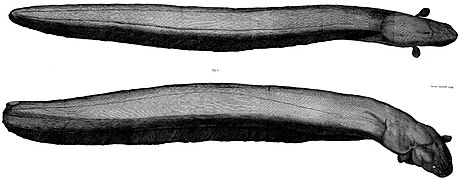
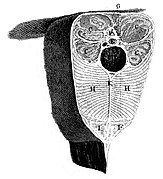
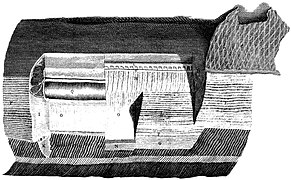
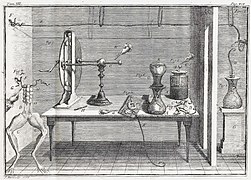

![Electrodes touch a frog, and the legs twitch into the upward position[11]](http://upload.wikimedia.org/wikipedia/commons/thumb/c/c7/Galvani-frogs-legs-electricity.jpg/220px-Galvani-frogs-legs-electricity.jpg)


